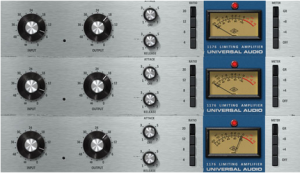
Do compressors confuse you? And who don’t they confuse?
My just-posted Premier Guitar column covers some basics and walks you through a typical guitar compression scenario (with many audio examples).
Using a variation on a technique borrowed from engineer Michael Paul Stavrou’s cool recording technique book, Mixing with Your Mind, I start with extreme settings that make it easy to hear the compressor’s effect, and then back the processing down to realistic levels.
If you ever find yourself twiddling those inscrutable knobs while remaining unclear exactly what, if anything, is changing, this case study may clarify the process. I hope it’s helpful! :pacman:








I have an Xotic SP comp first thing in my chain after the tuner and it is always on. I have it set for unity gain basically it is about on 50% for everything and the 3 way toggle is on the mid setting. Pretty light and relatively unnoticeable , it just tightens up the signal before it gets to the rest of the chain and gives it focus. The rough mix sounds best to me right off but it is not at any sort of volume out of my computer speakers in the early a.m.This is not a Tele squished down with a dynacomp from Nashville.(or insert somewhat famous comp sound here)
Thank you for this, Joe. I found it very helpful and informative.
Joe, that article is a great explanation of how to actually use a compressor on recorded tracks, but what are your thoughts on using compressor pedals with an electric guitar and amplifier (where the guitar and amp aren't acoustically isolated form each other as they sometimes are in a studio situation)?
Guitarists may have trouble using compressor pedals because, as you say the effects aren't super obvious until you crank them to the limit. It seems to me that a lot of the feel of a using a great valve amp cranked up can be gained by using a compressor pedal, even at lower volumes. What's interesting is that the compression, to me at least, seems to make a guitar more responsive. Small changes in fingering and picking are enhanced, there is more sustain and controlled feedback occurs more readily. Of course many distortion pedals have something of a similar effect because they add gain and then clip / limit the signal, but a compressor pedal produces a cleaner sound.
Wow, great question! I rarely use compressors that way myself, but players far more talanted than I have done so to great effect. To my ear, other elements in the signal path provide plenty of compression (especially distortion pedals and amp overdrive). And then there’s compression added in input … and to the track … and on the mix bus. And then again when mastering. Though you know, it can be a fine line between a compressor and a preamp — sometimes compressors sound great in front of an amp just because they’re adding a bit of gain.
I totally get what you’re saying about touch, though. Depending on your picking-hand technique, compression might bring out really nice things. And I almost always tend to play through a bit of compression/gain when performing on acoustic guitar through an electric amp.
I guess the one sound I really don’t care for is a clean-toned electric guitar with with thin strings, low action, and little intrinsic sustain, pumped up artificially with compression.
“aaaaaaaaahhhhhhhhhh…..”
I always used the presets on compressors until I read Stav’s book. The technique described completely demystified them for me. It’s an expensive book but one of the best ‘gear’ purchases I ever made!! Great article Joe (as usual)!!